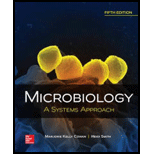
Concept explainers
Introduction:
The humans are connected with a vast array of microbes known as resident biota. A holobiont includes the human body along with resident biota. These microbes of resident biota also prevent the overgrowth of harmful microorganisms.
Answer to Problem 1MCQ
Correct answer:
The best descriptive term for the resident biota is commensals. Therefore, option (a) is correct.
Option (a) is given as “commensals”.
Explanation of Solution
Justify reasons for the correct statement:
Some organisms show evolution along with its human hosts and produce a complex relationship in which the effects of normal biota are not deleterious to the host. Normal biota is generally either in a commensal or mutualistic association with their hosts because microbes exist in different kinds of relationships with their hosts.
Hence, option (a) is correct.
Justify reasons for the incorrect statements:
Option (b) is given as “
The parasites are the organisms which can live on host body, but they do not live in commensals like microorganisms. Hence, it is a wrong answer.
Option (c) is given as “pathogens”.
Not all pathogens live in commensals. Only some microorganisms live in commensals. Hence, it is a wrong answer.
Option (d) is given as “mutualists”.
Mutualists are the organisms which live in a relationship such that both the organisms are benefitted. Hence, it is a wrong answer.
Hence, options (b),(c), and(d) are incorrect.
The commensals are the microorganisms which live in a group. The resident biotas are also commensals.
Want to see more full solutions like this?
Chapter 13 Solutions
Microbiology: A Systems Approach
- The most abundant component ofplasma is .a. wasteb. oxygenc. proteinsd. waterarrow_forwardwhich of the following is a result of colonization by mutualistic and commensal microbes? (multiple answers) a. the human microbiomes b. the gut microbiota c. gut dysbiosis d. enterotypes. E. A C. difficile infection.arrow_forwardDefine the following terms:a. endotoxinb. periplasmic spacec. biofilmd. slime layere. bacterial capsulearrow_forward
- Foodborne pathogens often require the presence of a large number of microbes before an active infection results. These microbes would have a high A.) median infectious dose (ID50). B.) incubation period. C.) virulence. D.) median lethal dose (LD50). E.) mortality.arrow_forwardan agent that is bacteriostatic: a. kills algae b. kills bacteria c. inhibits the growth of fungi d. inhibits the growth of bacteriaarrow_forwardwhich of the following definitions is not technically correct? a. broad spectrum - effective against many different types of microbes b. bacteriostatic - prevents microbes from growing c. antibiotic - microbial or synthetic product that kills or inhibits growth of microbes. d. all of the above are correctarrow_forward
- A(n) _______ organism is part of the normal microbial flora of the host A. Acquired B. Symbiotic C. Commensal D. Secondaryarrow_forwardWhy antibacterial drugs are ineffective against: A. Fungal Infections B. Viral infections C. Helminthic worm infectionsarrow_forwardWhich of the following statements is incorrect? a. Mucosal surfaces are better than skin surfaces at supporting colonization by commensal microorganisms. b. The skin provides a larger surface area than mucosal surfaces for commensal microorganisms. c. There are ten times as many bacteria residing in the intestinal tract than the number of cells in the human body. d. It is common for commensal bacteria to live in symbiosis with their human hosts. e. During gestation in mammals, a fetus does not have any commensal microorganisms on their skin or mucosal surfaces.arrow_forward
- When Pathogens destroy Normal flora, it can lead to: a. Large inoculum b. Physical destruction of host cells c. Infection d. All of the abovearrow_forwardDefine the following terms: a. endotoxin b. periplasmic space c. slime layer d. lipopolysaccharide e. pilusarrow_forwardAn area of microbiology that is concerned with the occurrence of disease in human populations is a. immunology b. parasitology c. epidemiology d. bioremediationarrow_forward
- Basic Clinical Lab Competencies for Respiratory C...NursingISBN:9781285244662Author:WhitePublisher:Cengage
 Comprehensive Medical Assisting: Administrative a...NursingISBN:9781305964792Author:Wilburta Q. Lindh, Carol D. Tamparo, Barbara M. Dahl, Julie Morris, Cindy CorreaPublisher:Cengage Learning
Comprehensive Medical Assisting: Administrative a...NursingISBN:9781305964792Author:Wilburta Q. Lindh, Carol D. Tamparo, Barbara M. Dahl, Julie Morris, Cindy CorreaPublisher:Cengage Learning

